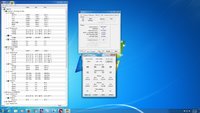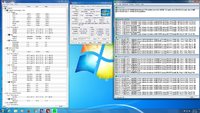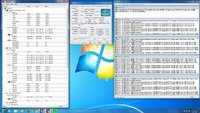*edited slightly to make post shorter and a little more concise*
Hi everyone, Attempting my first overclock ever on my current pc with the i5-2500k processor. Just looking for some guidance/reassurance that I'm doing it right here. I have been trying to read as many guides as possible on OC'ing this chip, but being a total beginner, I'm still a little confused.
PC Specs:
pre-built IBuyPower pc
CPU: i5-2500k
Cooler: Thermaltake SpinQ
Mobo: Gigabyte z68a-d3-b3
Ram: A-DATA 8GB ddr3 1366
GPU: GTX 560 Ti
SSD: Samsung 850 evo 256gb
OS: Win7 pro
With my motherboard/BIOS, when I change the cpu clock ratio, BIOS sets the vcore for me, I cannot manually set vcore. Current settings:
CPU Clock 40x (stock 33)
Vcore 1.32 (stock 1.224) *This is set by bios when I change my clock*
Internal CPU PLL overvoltage - Auto (stock auto)
Real time ratio changes in os - Enabled (stock disabled) *This disabled turbo boost*
All C-States - Auto (stock auto)
Load Line Calibration - Enabled (stock Auto) *Only have enabled, disabled, auto*
Dynamic Vcore +0.000V - Auto (stock auto)
All ram settings left on auto, or where-ever they were stock. Saved, rebooted to windows, ran Prime95 for like 2hrs15min with no errors and played a few games of CS with no problems.
Pic of results after p95

Temps are safe so far right? 67* max temp.
Need some help with VCORE and VID. As you can see, HWmonitor and cpu-z is showing a vcore of 1.296, but HWmonitor and Realtemp are showing a VID of 1.386. Is this normal, and is it safe?
Here is a pic of HWmonitor, cpu-z, and real temp taken right now.

Am I doing ok so far?
Thanks for any help guys, I really hate being the millionth guy asking about a 2500k overclock, so I do apoligize for that!
Hi everyone, Attempting my first overclock ever on my current pc with the i5-2500k processor. Just looking for some guidance/reassurance that I'm doing it right here. I have been trying to read as many guides as possible on OC'ing this chip, but being a total beginner, I'm still a little confused.
PC Specs:
pre-built IBuyPower pc
CPU: i5-2500k
Cooler: Thermaltake SpinQ
Mobo: Gigabyte z68a-d3-b3
Ram: A-DATA 8GB ddr3 1366
GPU: GTX 560 Ti
SSD: Samsung 850 evo 256gb
OS: Win7 pro
With my motherboard/BIOS, when I change the cpu clock ratio, BIOS sets the vcore for me, I cannot manually set vcore. Current settings:
CPU Clock 40x (stock 33)
Vcore 1.32 (stock 1.224) *This is set by bios when I change my clock*
Internal CPU PLL overvoltage - Auto (stock auto)
Real time ratio changes in os - Enabled (stock disabled) *This disabled turbo boost*
All C-States - Auto (stock auto)
Load Line Calibration - Enabled (stock Auto) *Only have enabled, disabled, auto*
Dynamic Vcore +0.000V - Auto (stock auto)
All ram settings left on auto, or where-ever they were stock. Saved, rebooted to windows, ran Prime95 for like 2hrs15min with no errors and played a few games of CS with no problems.
Pic of results after p95

Temps are safe so far right? 67* max temp.
Need some help with VCORE and VID. As you can see, HWmonitor and cpu-z is showing a vcore of 1.296, but HWmonitor and Realtemp are showing a VID of 1.386. Is this normal, and is it safe?
Here is a pic of HWmonitor, cpu-z, and real temp taken right now.

Am I doing ok so far?
Thanks for any help guys, I really hate being the millionth guy asking about a 2500k overclock, so I do apoligize for that!
Last edited:
![[H]ard|Forum](/styles/hardforum/xenforo/logo_dark.png)


